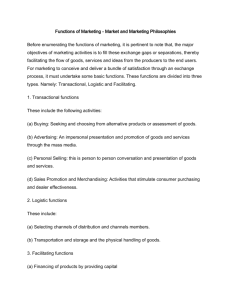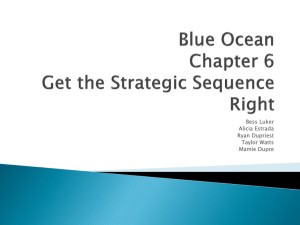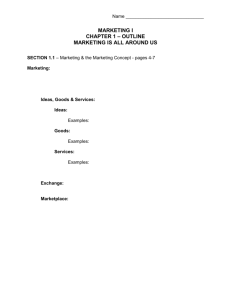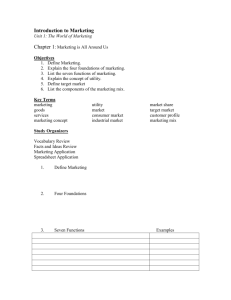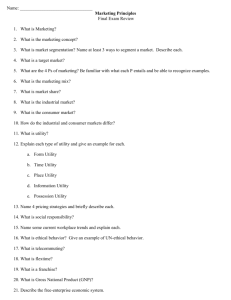intro bus-midterm - Assumption University
advertisement
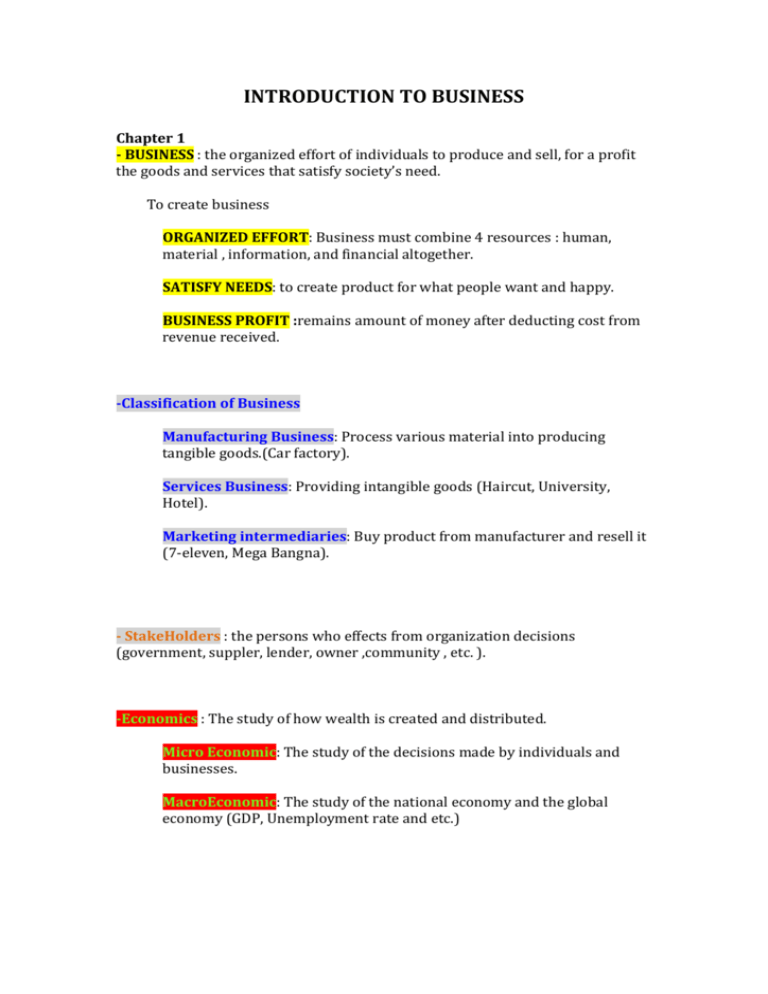
INTRODUCTION TO BUSINESS Chapter 1 - BUSINESS : the organized effort of individuals to produce and sell, for a profit the goods and services that satisfy society’s need. To create business ORGANIZED EFFORT: Business must combine 4 resources : human, material , information, and financial altogether. SATISFY NEEDS: to create product for what people want and happy. BUSINESS PROFIT :remains amount of money after deducting cost from revenue received. -Classification of Business Manufacturing Business: Process various material into producing tangible goods.(Car factory). Services Business: Providing intangible goods (Haircut, University, Hotel). Marketing intermediaries: Buy product from manufacturer and resell it (7-eleven, Mega Bangna). - StakeHolders : the persons who effects from organization decisions (government, suppler, lender, owner ,community , etc. ). -Economics : The study of how wealth is created and distributed. Micro Economic: The study of the decisions made by individuals and businesses. MacroEconomic: The study of the national economy and the global economy (GDP, Unemployment rate and etc.) -Micro Economic Perfect Competition: Market situation where there are many sellers and buyers and none of them powerful enough affect the price of product.(Price are set only base on demand and supply) Monopolistic: Market situation where there are many sellers and buyers who relatively differentiate their particular product from competitors. (can control price higher than others) (our product is better) Oligopoly: Market situation with few sellers (Boeing, Airbus, DTAC, AIS). Monopoly: Market situation with only one seller Natural monopoly : (unique material and hard to produce) : Electricity Legal Monopoly : (when government entity issues copyright) : Lottery - Economic System Capitalism: Limited role of government, business and individual control what to do and how to produce. -Mix Economy : Is the mix between Capitalism and Command economy. Command Economy:is high role of government or the government decides what will be produced, how it will be produced. Two type of economic system under Command economy -Socialism:government controlsKey industries (transportation, utilities, and banking) ex. China, Sweden -Communism : all factors of production are owned and controlled by the government ex. North Korea, Cuba - Factors of production -Land / Natural Resources -Labor / Human Resources -Capital (Money, Materials) -Entrepreneurship -Measuring Economic Performance (Business cycle and Economic policy) Productivity -A ratio of production output is required to produce inputs. -The average level of output per worker per hour. Economic Indicators -(GDP) or Gross Domestic Product : Total value of product produce in that country. :GDP growth rate :Percentage change in GDP. -Unemployment : The percentage of a state labor forces unemployed, they have ability, they are capable but they have no job. - Inflation and Deflation : Inflation is a general increase in the prices level.Deflationis a general decrease in the prices level, that these prices measured by Consumer price index or CPI -Consumer price index or CPI : Average of prices in a basket of consumer goods and services. -Business cycle -Prosperity or peak -Recession or contraction -Trough or depression -Recovery -Economic Problems -Inflationary : a strong in rising level of demand (Economic Boom). -Recessionary : a contraction in level of demand (Economic Downturn). -Economic Policy -Monetary policies :Central bank’s decisions that control the size of the money supply in the nation and the level of interest rates. -Fiscal policy :Government control on the amount of savings and expenditures by setting the tax and by changing the levels of government spending. Chapter 8 Customer Relationship through Effective Marketing Marketing definition The activity set of institutions, and processes for creating, communicating, delivering, and exchanging offerings that have value for customers. Clients, partners, and society at large Activities and processes Creating, communicating, delivering, and exchanging products For customers, clients Managing Customer Relationship 1. Relationship marketing Establishing long-term, mutually satisfying buyer seller relationship. 2. Customer relationship management (CRM) Using information about customers to create marking strategies. 3. Customer lifetime value A combination of purchase frequency, value of customer over lifetime (long-term) Utility : ability of the goods and the services satisfy a human need. Marketing -Form utility - Time utility - Place utility - Possession utility Form utility : Everything you can see and touch such as shape, design, sixe of shoes. Time utility : Making product available when customer wants the product. Place utility : Making product available at a location. Possession utility : Transferring to buyer ownership of a product to a buyer. Type of Marketing B2C : not buy product to make profit. : personal use, family use/ not to make a profit : buy for use only B2B : make a profit - Producers : buy products to use in the manufacture - Reseller : buy product and sell for a profit - Government : highways, education, utilities, defense - Institutions : earn for profit such as church, hospital, school Customer relationship management (CRM) 1. Define target market Market segmentation Demographic Psychographic Geographic Age Personality Country Gender Lifestyle Region Race Feeling Urban Income Interest Rural Education Motives climate Occupation Religion 2. Marketing mix and marketing environment The firm generally has no control at all - Economic forces - Competitive forces - Social/cultural forces - Technological forces - Political forces - Legal and regulatory forces 4PS - Product Price Place Promotion Behavoristic Volume usage End use Brand loyality Breakeven Analysis The calculation Total revenues: The total amount received from sales of a product Unit Sold Selling Price Revenues 0 20 0 x 20 = 0 1 20 1 x 20 = 20 10 20 10 x 20 = 200 Total Revenues (TR) =Selling Price (SP)×Unit Sold (Q) Total Cost: The total amount paid to produce a product Total Variable Cost (TVC) =Quantity (Q) ×variable cost (VC) Unit Sold 0 1 10 VC per unit 5 5 5 Total Variable Cost 0x5=0 1x5=5 10 x 5 = 50 Total cost (TC) = Total Fixed Cost (TFC) + Total Variable Cost (TVC) Unit Sold 0 1 10 TFC 7000 7000 7000 TVC 0 5 50 Total Cost 7000 7005 7050 Calculating breakeven Total Revenues (TR) = Total Cost (TC) 𝑇𝐹𝐶 Finding break even in units, use this formula 𝑄 = Finding breakeven in dollars, use Quantity in formula above multiply by selling price(SP) 𝑆𝑃−𝑉𝐶 CH.9 Creating Pricing Products Product: Whatever you can sell,tangible,intangible Classification of product -Consumer product: A product purchased to satisfy personal and family needs 1.Convenient Product-A relatively inexpensive,frequently purchased item for which buyers want to exert only minimum effort e.g. Gum,Candy,Drinking water 2.Shopping Product-An item for which buyers are willing to expend considerable effort on planning and making the purchase e.g. Appliance,cosmetics 3.Specialty Product-The items that have one or more unique characteristics for which a group of buyers is willing to expend considerable purchasing effort(no substitute) e.g. Super car -Business Product:A product bought for resale,for making other products,or for use in a firm’s operations. Product Life Cycle A series of stages in which a product’s sales revenue and profit increase , reach the peak , then decline. Introduction -Product Awareness -Promotional campaigns concentrate on features,uses and benefits -Financial losses are common due to low initial sales and heavy promotional costs -Facing only limited competition,it might use a skimming-pricing approach -Distribute through just a few channel Growth -Sales climb quickly -Firm usually begins to realize profits due to higher sales volume. -Marketing efforts continue to focus on establishing the product in the market and building brand awareness. -Later in growth stage,the strategy shifts to building loyalty -Additional spending on product adaptation,promotion and distribution,along with lower prices mat necessary -Distribute through multiple channel Maturity -Industry sales continue to grow at a decreasing rate(eventually reach a plateau) -Companies emphasize market segmentation -Some firms reduce prices and/or spend heavily on promotion -Advertising use to differentiate the product from competitor -Profits depend on sales Decline -Innovations of shifts in consumer preferences cause an absolute decline in industry sales -Industry as a whole does not generate profits,though some firms can prosper -Prices tend to hold steady if a loyal market segment continues to buy the product -If the firm is selling to customers who are loyal,they can skip most of the usual advertising Product Line- A group of similar products that differs only in realtively minor characteristics e.g. iphone4s iphone5 iphone5s Product mix-All of the products that firm offers for sale The width of the mix:The number of product lines the Mix contains The Depth of the mix:The number of products within each line. Branding(Brand:A name,symbol,design that identifies a seller’s product) -Brand name Brand mark(symbol) -Trade name Trade mark Packaging and labeling : graphic or information over the package -Protect the product and easy to transport -Offer consumer convenience -Promote the product Product Pricing Price competition-An emphasis on setting a price equal to or lower than competitors’ prices to gain sales or market share Non Price competition-Competition based on factors other than price(such as quality,customer service,packaging) Pricing Method -Competition based pricing-Based on the challenge of competitors’ prices in markets where products are quite similar or price is an important customer consideration -Demand-Based pricing-Based on the level of customer demand for the product.Product prices are high when the demand is high and low when demand is weak. •Price differentiation-setting different prices in segmented markets based on segment characteristics -Cost-Based Pricing-The seller determines the total cost of producing one unit of the product then adds an amount to cover additional costs and profit(mark-up_ •Be facilitated through the use of “Breakeven Analysis” Chapter 11 Integrate Marketing Communication The coordination of promotion efforts to ensure their maximal information an persuasive impact on customers Promotional Mix Advertising Personal Selling Sale Promotion Public Relation Advertising A paid non-personal message communicated to a select audience through a mass medium Personal Selling Personal communication aimed at informing customers and persuading them to buy a firm’s products Sale Promotion Activities or materials that are direct inducements (incentive) to customers Public Relations Communication activities used to create and maintain farvorable relation between an organization and various public groups
